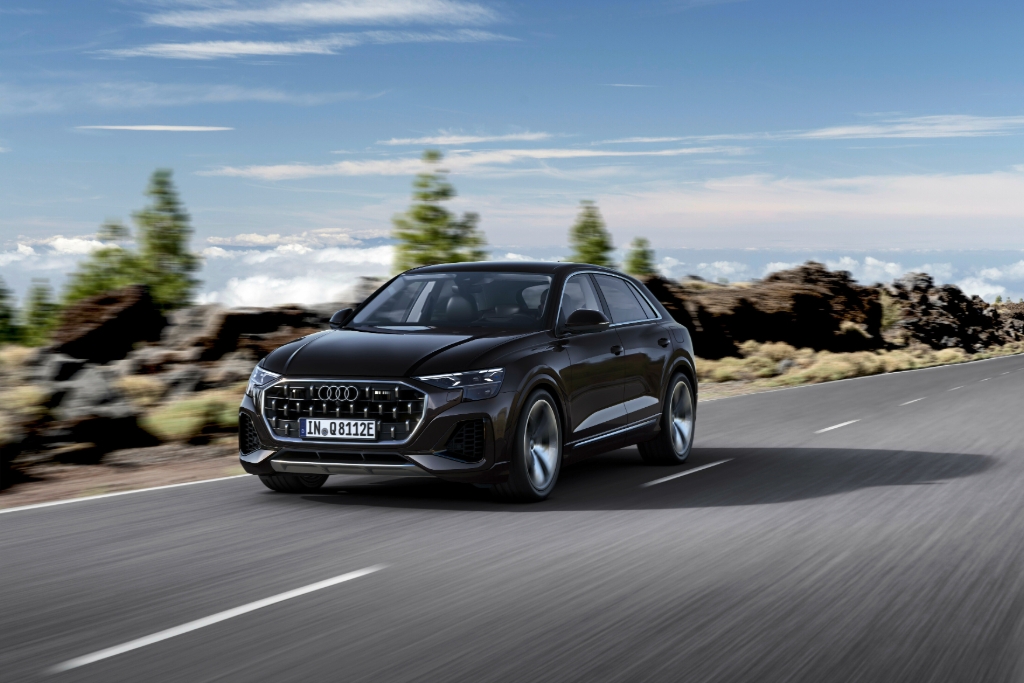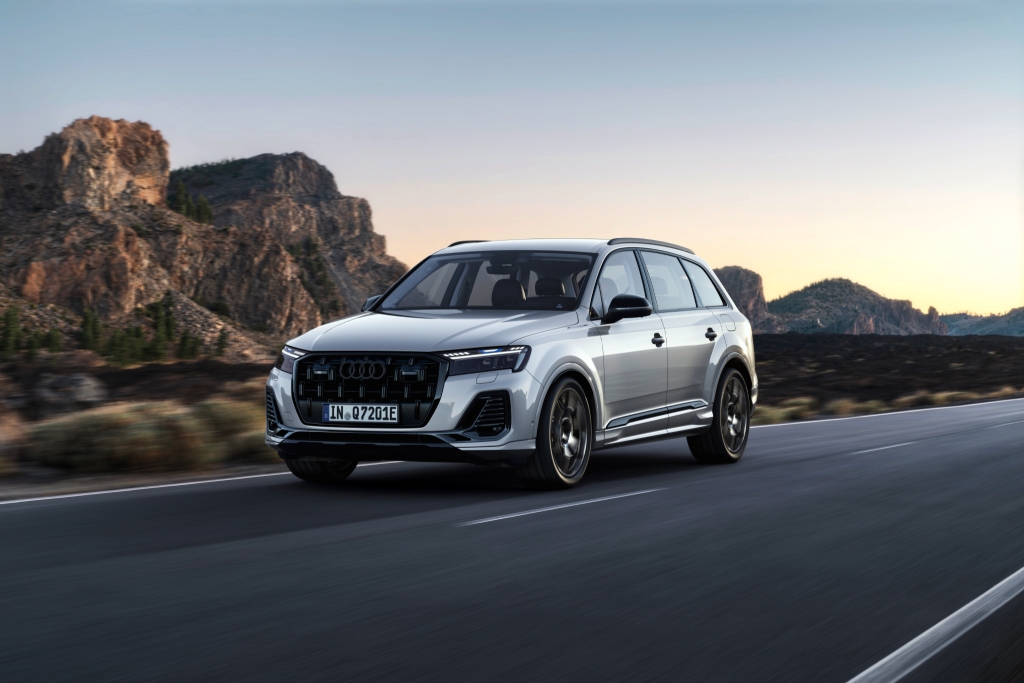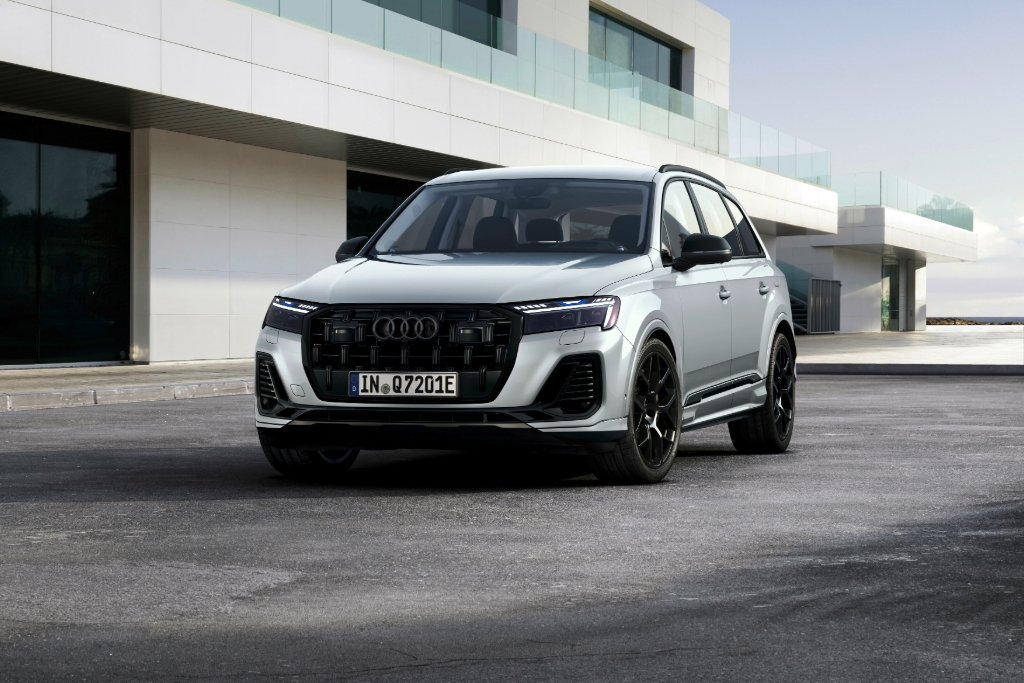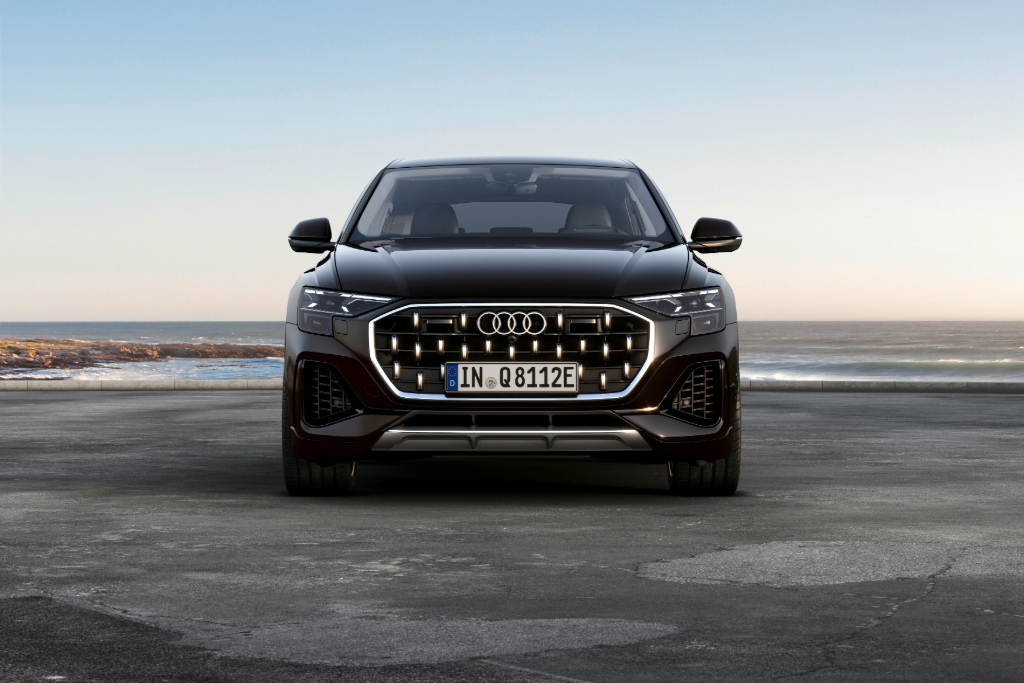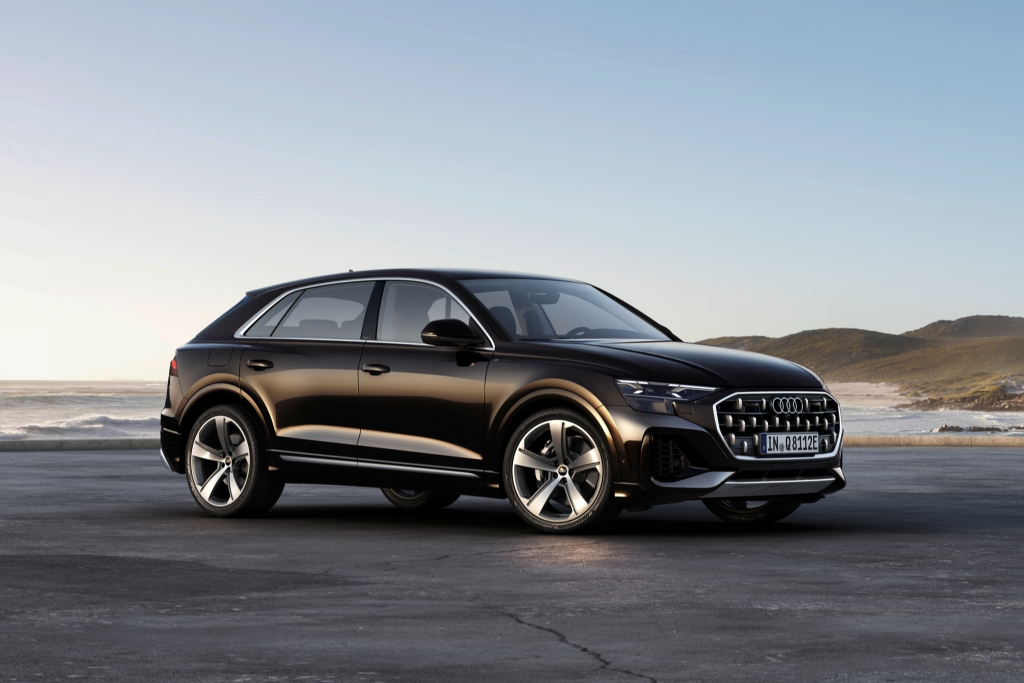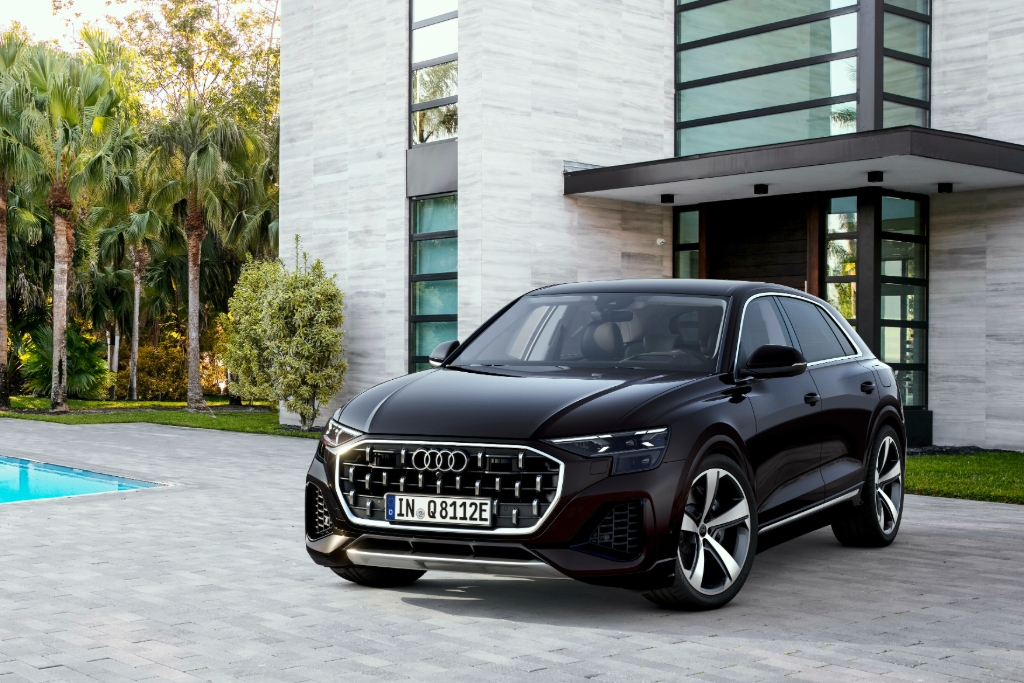Plug-in hybrid Audi Q7 and Q8 get fresh update
25 Apr 2024|661 views
Audi has updated the plug-in hybrid iterations of its Q7 and Q8 SUV.
Both models continue to be make use of a 3.0 six-cylinder engine that delivers 335bhp. This engine is paired with an electric motor which offers a 130kW output alongside 460Nm of peak torque. The SUVs also now get a new liquid-cooled battery. The compact design of this battery housing eliminates the need for additional module housing while providing a higher power density. This new battery offers maximum capacity of 25.9kWh, facilitating an electric-only range of 83km and 82km on the Q7 and Q8 respectively.
Both the Q7 (in white) and the Q8 (in black) received extensive updates to the battery, increasing its range, more specifically, increasing its all electric range by 83km and 82km respectively
The maximum system output of the 55 TFSI e quattro for both the Q7 and Q8 now stands at 388bhp, while both cars will deliver a total of 600Nm of torque, thanks a new design electric motor. This power output allows these SUVs to go from zero to 100km/h in just 5.7 seconds and to hit a top speed of 239km/h. Both cars will also hit a top speed of 135km/h when running on electric power alone.
The batteries of these SUVs can be charged at 7.4kW. At this power, both vehicles can charge to 100% capacity in approximately three hours and 45 minutes.
Customers are now able to start their Q7 or Q8 in fully electric EV mode or hybrid mode thanks to the product upgrade. The desired mode remains active until it is manually changed after being selected in the MMI infotainment system. The car's 'EV' mode has been refined, ensuring that only battery-powered propulsion is used even in an event where the accelerator pedal is fully depressed.
Hybrid mode on the other hand uses two operating modes - auto and hold. When in auto mode, the predictive operating strategy automatically activates when navigation is started in the standard MMI navigation plus. The 3.0-litre engine is the primary provider of acceleration and is supported by the electric motor when needed.
When the car is driven al low engine speeds, the electric drive bridges the fraction of a second that the turbocharger takes to build up pressure, allowing the drive system to respond spontaneously.
'Hold' mode, meanwhiel maintains the existing battery charge at its current level with minimal fluctuations. This is achieved by recovering braking energy through recuperation, allowing the user to drive to urban destinations on all-electric power, with zero emissions and almost zero sound.
The product upgrade also comes with a new feature. The battery is now able to recharge intelligently and only above speeds of about 64km/h when in charge mode. This feature maximises efficiency while ensuring high levels of electric driving in the city and in stop-and-go traffic.
That is not all for these SUV's efficiency updates! In 'charge' mode, the 3.0-litre engine will no longer constantly be used to charge the battery, rather, only recuperation will be used. Charge mode will end when the battery has recharged to its maximum capacity at 75%, conserving battery and increasing efficiency.
When the accelerator pedal is not depressed, the operating strategy switches to Predictive Efficiency Assist (PEA). On top of navigation data, this driver assistance system uses the distance to the vehicle in front to decide between coasting with the TFSI switched off and recuperation. In thrust phases, the Q7 and Q8 TFSI e can recover up to 25kW of power and feed it back into its lithium-ion battery.
Acting as the vehicles' generator, the electric motor performs all light to moderate braking up to 0.3g, which is approximately more than 90% of all deceleration events in everyday driving. The hydraulic wheel brakes are only needed during heavy braking. The hybrid SUV can achieve up to 80kW of recuperation power during braking.
PEA also helps with deceleration and fuel-saving acceleration when the cruise assist with radar cruise control is active. In an event where it is turned off, the Audi virtual cockpit or optional head-up display comes into play, indicating when the driver should take their foot off the right pedal. In addition to this, detail icons such as intersections, city signs or vehicle ahead illustrates the reason for the reduction in speed.
Each vehicle is fitted with high-intensity Matrix LED head lights as a standard, with HD Matrix LED head lights with Audi laser light as an additional high beam for an increased beam range featuring on Vorsprung models. These top-of-the-range head lights come with digital daytime running light signatures. The head lights give the Q7 and Q8 a characteristic and unmistakable appearance, and users will be able to select one of four light signatures via the MMI. Vorsprung models will see largely digitalised OLED rear lights with digital signatures.
Similar to the product upgrade of the TFSI and TDI versions, the Q7 and Q8 will have a significantly upgraded equipment range. Customers can now choose from a range of three new finishes and wheels, including new designs ranging from 20 to 23-inch in size, depending on the model. The range of apps and assistance systems have also expanded.
In terms of standard equipment, 20-inch alloy wheels, a rearview camera, Audi virtual cockpit plus, three-zone automatic climate control and adaptive air suspension have been added. Both models are also now fitted with Mode 3 charging cable as a standard.
As a standard and stating true to Audi's DNA, electronically controlled air suspension with a continuously adaptive damping system is fitted into the Q7 and Q8. Both cars will additionally come with all-wheel steering, which is able to steer the rear wheels up to five degrees in the opposite direction of the front wheels, reducing the turning radius and increasing manoeuvrability.
The electromechanical active roll stabilisation (eAWS) ensures even more dynamics as another option for plug-in hybrids. Both axles are equipped with a compact electric motor, linked to a transmission in this system. This allows them to work mostly independently, reducing body movements on uneven roads. In sporty driving however, the electric motors work together as a unit, reducing roll when driving though a curve and allowing more precise steering response. The eAWS is powered by a 48V supercapacitor.
Audi states that customers in the U.K. can look forward to the release of the pricing of these facelifted cars soon.
Audi has updated the plug-in hybrid iterations of its Q7 and Q8 SUV.
Both models continue to be make use of a 3.0 six-cylinder engine that delivers 335bhp. This engine is paired with an electric motor which offers a 130kW output alongside 460Nm of peak torque. The SUVs also now get a new liquid-cooled battery. The compact design of this battery housing eliminates the need for additional module housing while providing a higher power density. This new battery offers maximum capacity of 25.9kWh, facilitating an electric-only range of 83km and 82km on the Q7 and Q8 respectively.
Both the Q7 (in white) and the Q8 (in black) received extensive updates to the battery, increasing its range, more specifically, increasing its all electric range by 83km and 82km respectively
The maximum system output of the 55 TFSI e quattro for both the Q7 and Q8 now stands at 388bhp, while both cars will deliver a total of 600Nm of torque, thanks a new design electric motor. This power output allows these SUVs to go from zero to 100km/h in just 5.7 seconds and to hit a top speed of 239km/h. Both cars will also hit a top speed of 135km/h when running on electric power alone.
The batteries of these SUVs can be charged at 7.4kW. At this power, both vehicles can charge to 100% capacity in approximately three hours and 45 minutes.
Customers are now able to start their Q7 or Q8 in fully electric EV mode or hybrid mode thanks to the product upgrade. The desired mode remains active until it is manually changed after being selected in the MMI infotainment system. The car's 'EV' mode has been refined, ensuring that only battery-powered propulsion is used even in an event where the accelerator pedal is fully depressed.
Hybrid mode on the other hand uses two operating modes - auto and hold. When in auto mode, the predictive operating strategy automatically activates when navigation is started in the standard MMI navigation plus. The 3.0-litre engine is the primary provider of acceleration and is supported by the electric motor when needed.
When the car is driven al low engine speeds, the electric drive bridges the fraction of a second that the turbocharger takes to build up pressure, allowing the drive system to respond spontaneously.
'Hold' mode, meanwhiel maintains the existing battery charge at its current level with minimal fluctuations. This is achieved by recovering braking energy through recuperation, allowing the user to drive to urban destinations on all-electric power, with zero emissions and almost zero sound.
The product upgrade also comes with a new feature. The battery is now able to recharge intelligently and only above speeds of about 64km/h when in charge mode. This feature maximises efficiency while ensuring high levels of electric driving in the city and in stop-and-go traffic.
That is not all for these SUV's efficiency updates! In 'charge' mode, the 3.0-litre engine will no longer constantly be used to charge the battery, rather, only recuperation will be used. Charge mode will end when the battery has recharged to its maximum capacity at 75%, conserving battery and increasing efficiency.
When the accelerator pedal is not depressed, the operating strategy switches to Predictive Efficiency Assist (PEA). On top of navigation data, this driver assistance system uses the distance to the vehicle in front to decide between coasting with the TFSI switched off and recuperation. In thrust phases, the Q7 and Q8 TFSI e can recover up to 25kW of power and feed it back into its lithium-ion battery.
Acting as the vehicles' generator, the electric motor performs all light to moderate braking up to 0.3g, which is approximately more than 90% of all deceleration events in everyday driving. The hydraulic wheel brakes are only needed during heavy braking. The hybrid SUV can achieve up to 80kW of recuperation power during braking.
PEA also helps with deceleration and fuel-saving acceleration when the cruise assist with radar cruise control is active. In an event where it is turned off, the Audi virtual cockpit or optional head-up display comes into play, indicating when the driver should take their foot off the right pedal. In addition to this, detail icons such as intersections, city signs or vehicle ahead illustrates the reason for the reduction in speed.
Each vehicle is fitted with high-intensity Matrix LED head lights as a standard, with HD Matrix LED head lights with Audi laser light as an additional high beam for an increased beam range featuring on Vorsprung models. These top-of-the-range head lights come with digital daytime running light signatures. The head lights give the Q7 and Q8 a characteristic and unmistakable appearance, and users will be able to select one of four light signatures via the MMI. Vorsprung models will see largely digitalised OLED rear lights with digital signatures.
Similar to the product upgrade of the TFSI and TDI versions, the Q7 and Q8 will have a significantly upgraded equipment range. Customers can now choose from a range of three new finishes and wheels, including new designs ranging from 20 to 23-inch in size, depending on the model. The range of apps and assistance systems have also expanded.
In terms of standard equipment, 20-inch alloy wheels, a rearview camera, Audi virtual cockpit plus, three-zone automatic climate control and adaptive air suspension have been added. Both models are also now fitted with Mode 3 charging cable as a standard.
As a standard and stating true to Audi's DNA, electronically controlled air suspension with a continuously adaptive damping system is fitted into the Q7 and Q8. Both cars will additionally come with all-wheel steering, which is able to steer the rear wheels up to five degrees in the opposite direction of the front wheels, reducing the turning radius and increasing manoeuvrability.
The electromechanical active roll stabilisation (eAWS) ensures even more dynamics as another option for plug-in hybrids. Both axles are equipped with a compact electric motor, linked to a transmission in this system. This allows them to work mostly independently, reducing body movements on uneven roads. In sporty driving however, the electric motors work together as a unit, reducing roll when driving though a curve and allowing more precise steering response. The eAWS is powered by a 48V supercapacitor.
Audi states that customers in the U.K. can look forward to the release of the pricing of these facelifted cars soon.
Latest COE Prices
November 2025 | 2nd BIDDING
NEXT TENDER: 03 Dec 2025
CAT A$109,000
CAT B$129,890
CAT C$76,389
CAT E$125,001
View Full Results Thank You For Your Subscription.







